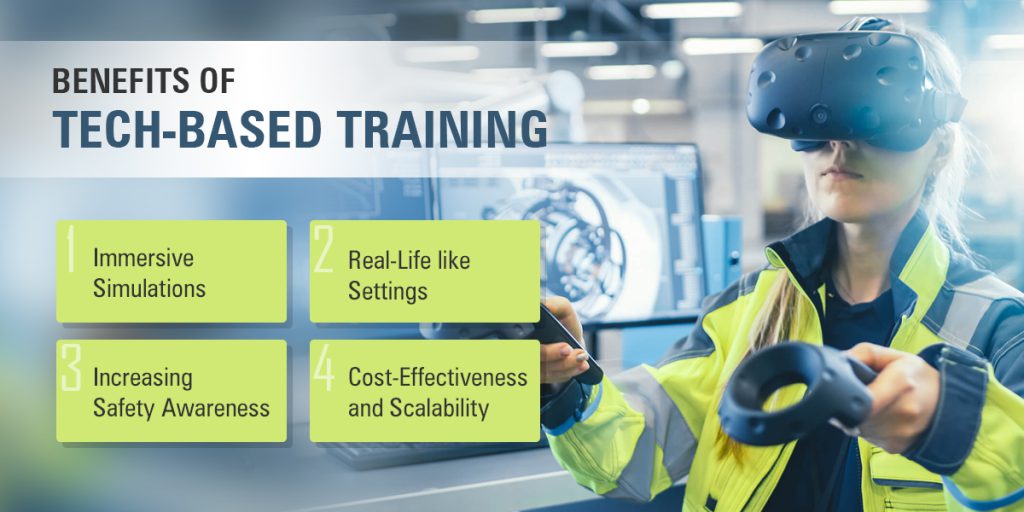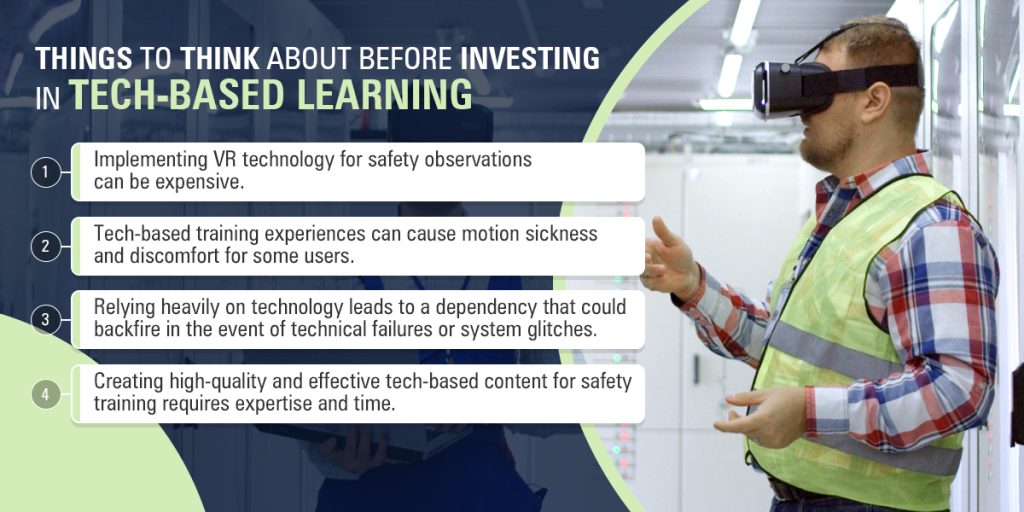The Role of Virtual Reality in Safety Observations: Enhancing Training and Awareness

When you see a billboard while driving or walking on the street, the first thing you notice are the images. Also, when you come across an eye-catching image, post the image attention, you want to read the text following it. So, the bottom line is that the human brain captures the image and processes it before the text!
Therefore, this is a crucial aspect of enhancing safety training methods.
Now, if workers watch videos instead of verbal training, they tend to understand the training more deeply. But we can provide safety awareness training beyond visuals through virtual reality. For example, a worker faces a hazardous situation, and they can be tested in real-time with no injuries. Thus, we have escalated safety observation training along with a sense of how much the workers understand the training provided.
A similar case is the one with IoT sensors.
For example, the manufacturing industry is equipped with heavy machinery. Now, this machinery requires regular maintenance. If the device is equipped with IoT sensors, it sends regular notifications to the safety managers for scheduled maintenance. Also, if there is a minor malfunction, the system sends immediate alerts.
With the most advanced technology available, the safety observations of workplaces can be shaped with groundbreaking innovations. AI, IoT, VR, and more cutting-edge technologies can be implemented to make workplaces safer by enhancing training methods to another level.
In this blog, let us tell you more about how Virtual Reality, Artificial Intelligence, and other advanced technologies can enhance training and safety awareness programs.
Brief About Safety Observations
Safety observations are crucial in all workplace sectors, regardless of the industry.
They involve systematic assessments and evaluations conducted by employees or safety professionals to identify potential hazards, unsafe practices, or areas where safety measures can be and should be improved.
Some industry examples are;
#1. In manufacturing and industrial workplaces, safety observations are essential to identify risks associated with machinery, equipment, and production processes.
#2. Safety observations in construction focus on fall protection, electrical safety, equipment usage, and adherence to building codes.
#3. In the health sector, it involves assessing infection control practices, proper handling of medical equipment, and ensuring staff follow correct procedures to minimize the risk of patient harm.
#4. The corporate sector focuses on ergonomic issues, fire safety, electrical safety, and general workplace practices.
#5. In transportation and logistics, safety observations focus on vehicle maintenance, proper loading and unloading procedures, driver behavior, and adherence to traffic regulations.
Along with the above safety observations, regular maintenance, training, and maintaining proper records of the entire process are also part of the safety observations.
Therefore, when technology is incorporated into safety observations and safety awareness programs, it will make a measurable difference.
Lets see how it makes a difference!
How Technology Enhances Safety Training and Awareness
ASK EHS has come into the spotlight and every sector is taking it seriously, EHS technology is also evolving rapidly. Now, organizations can create immersive and realistic training environments to improve safety training and awareness.
1. Immersive Simulations
Immersive simulations with the help of VR-like technology ensure 100% employee engagement that the traditional safety training methods lack. These technologies immerse trainees in real-like and interactive environments. Employees’ reactions ensure that they pay proper attention to training programs and plan their reactions accordingly.
In fact, according to a study by PwC, VR-trained employees learn four times faster than in the classroom environment. Hence, there are numbers to prove that this accelerated learning leads to better retention of safety protocols and procedures, reducing the risk of accidents in the workplace.
2. Real-Life like Settings
For example, in the construction industry, where safety is paramount, VR-based training programs can significantly help. Workers can practice hazardous tasks in a safe virtual environment before executing them in real life.
And in the manufacturing sector, they can utilize VR simulations to train employees on complex machinery and assembly processes. VR allows trainees to interact with virtual prototypes, identify potential issues, and understand safety protocols thoroughly.
Thus, real-life like settings help the workers to get a glimpse of what they actually need to do and how they must do it.

3. Increasing Safety Awareness
Technology helps not only enhance training but also raise safety awareness among employees. By immersing individuals in realistic scenarios, they can experience firsthand the consequences of unsafe practices. Thus fostering a safety-conscious culture within organizations.
Infact, according to a survey conducted by EHS Today, companies that incorporated VR in their safety programs reported a 40% increase in safety awareness among employees.
4. Cost-Effectiveness and Scalability
Implementing technology-based safety training programs might seem like a significant investment initially. However, in the long run, it proves to be cost-effective.
Traditional training methods involve costs related to physical materials, travel, and downtime. The technology eliminates these expenses by providing a virtual platform accessible from any location. Moreover, digital investments like VR simulations can be easily updated to accommodate changing safety protocols, ensuring training remains relevant and up-to-date.
The technology-based training sessions enhance safety observations and ensure employees are at little or no risk while performing tasks Additionally, employees have a proactive approach when it comes to making safety observations or reporting near-misses.
But if we say goodbye to the traditional methods, does implementing technology for training have any cons?
Let us explore them, too.
#1. Implementing VR technology for safety observations can be expensive.
#2. Tech-based training experiences can cause motion sickness and discomfort for some users.
#3. Relying heavily on technology leads to a dependency that could backfire in the event of technical failures or system glitches.
#4. Creating high-quality and effective tech-based content for safety training requires expertise and time. Therefore, organizations must employ the best learning development expert to develop content.
But these cons are limited and can be turned to one’s benefits. If we really want to achieve a 100% safe and secure workplace, technology-based training is the answer. Because if an employee understands safety observations thoroughly, they will work more carefully, ruling out the possibility of human errors in accidents at the workplace.

To Conclude
By providing immersive and engaging training experiences, technology not only accelerates learning but also creates a culture of safety awareness within organizations.
With time, it is necessary that more industries recognize the potential of tech-based training, you can expect to see a continued decline in workplace accidents, ultimately fostering safer and healthier work environments for everyone involved.
FAQ(Frequently Asked Questions)
1. What is Virtual Reality (VR) and how is it used in safety observations?
Virtual Reality (VR) technology creates a simulated environment, allowing users to interact with 3D computer-generated environments. In safety observations, VR creates immersive training simulations that replicate real-world scenarios.
2. Does tech-based training enhance safety training compared to traditional methods?
Yes, tech-based training allows employees to practice safety protocols in lifelike situations and accelerates learning, improving retention while enabling trainees to make decisions in a risk-free environment.
3. Does technology-based learning require a significant investment for implementation?
Yes. But even if the initial costs are a consideration, there are long-term benefits, such as reduced accidents and improved safety awareness, outweigh the investment.



Thank you for taking the time to read and appreciate this article. I’m glad to hear that you found it valuable.